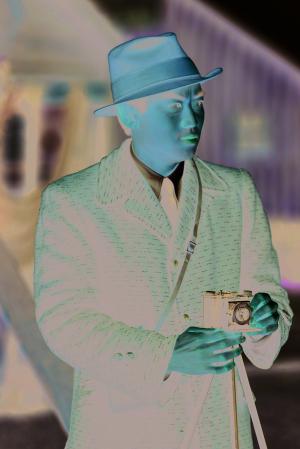News
Infamous and terrifying: AMC's first anthology horror series heads into Season 2

Derek Mio stars in "The Terror: Infamy"
The first season of AMC's chilling series "The Terror" garnered rave reviews, so of course the network has brought it back for Round 2. On Monday, Aug. 12, the second season of the channel's hit historical horror series (now christened as a yearly anthology program) returns, dubbed "The Terror: Infamy."
The altered title helps audiences differentiate the new season's storyline from last year's, because this is not a continuation of the first season's story, but a whole new tale of, well, terror.
The new season stars Derek Mio ("Seal Team") in the lead role of Chester Nakayama, a photographer who discovers creepy signs of the existence of an otherworldly presence in his pictures. Mio is supported by Shingo Usami ("The Pacific") and Naoko Mori ("Mamma Mia! Here We Go Again," 2018), who play his character's parents; Cristina Rodlo ("Too Old to Die Young") as his clandestine girlfriend, Luz; and C. Thomas Howell ("Animal Kingdom") as a retired soldier who oversees functions within the War Relocation Authority, the agency established to conduct the relocation and internment of Japanese-Americans during World War II.
Rounding out the cast is beloved veteran actor and activist George Takei ("Star Trek"), who plays Yamato-san, an experienced elder able to offer Nakayama wisdom and help him navigate the perilous threat posed by spirits out of Japanese folklore. In addition to his onscreen role, Takei also served as a consultant for the production. Having lived in an internment camp himself when he was young, he was an invaluable source of knowledge.
The first season of "The Terror" went into development in 2016, and was adapted -- quite faithfully -- from the novel of the same name by science fiction and horror author Dan Simmons. Simmons' book is based on a legitimate incident from real-life history: the disastrous lost expedition led by Englishman Sir John Franklin in 1845. Franklin and his crew intended to probe the Arctic region for the coveted Northwest Passage, but the two ships assigned to the task (HMS Erebus and HMS Terror) became icebound, and all 129 men who set out on the expedition perished. The wrecks of their ships remained undiscovered until 2014 and 2016.
To the already terrifying prospect of becoming stranded in Arctic ice, Simmons added his own piece of supernatural flair to rocket the story into truly brain-breaking territory. He added an unrelenting Arctic demon known as the Tuunbaq, which pursued and savaged the doomed survivors as they struggled to boat, sled and hike their way out of the grip of the northern ice.
"The Terror: Infamy" replicates that formula of real human history paired with a supernatural threat, but it relocates to an entirely different era. This season features a community of Japanese-Americans during World War II who are imprisoned in camps set up by a paranoid U.S. government after the attack on Pearl Harbor.

George Takei as seen in "The Terror: Infamy"
These Japanese-American internment camps are seen as a shameful moment in American history, and the story of the camps remains largely unexplored by American television. No series has ever focused on life inside those camps, let alone one that features a majority Asian and Asian-American cast like "The Terror: Infamy."
The new season juxtaposes the cruel fate of interned families with this season's new iteration of occult monstrosity. Unlike the Tuunbaq of Season 1, which was an invention of Dan Simmons, the preternatural baddie of "The Terror: Infamy" is a creature inspired by Japanese folklore, known as a bakemono. In Japanese mythology, a bakemono is understood to be a shape-shifting entity that disguises its original form.
The show is likely to take healthy liberties with its interpretation of the folkloric bakemono. This season's evil creature needs to deliver a horrifying visual punch equal to that of the Tuunbaq's mutated zombie polar bear from Season 1, while simultaneously expanding upon the traditional Japanese mythology to explain why a spirit from so far away might pursue individuals across oceans to their new homes in America.
The first season of the show was able to count on a sturdy plot derived from Simmons' novel, but now that the series has turned into an anthology, showrunners have a whole new set of challenges. Unlike "American Horror Story," which typically retains a number of core cast members from season to season, "The Terror" anthology looks as if it will require audiences to embrace an entirely new set of performers every year.
On the other hand, if "The Terror: Infamy" is as successful as the original season was, there will be limitless opportunities for the show to expand and plunder mythology and folklore from around the world and throughout history. Find out if the anthology format is a good fit for this series when Season 2 premieres Monday, Aug. 12, on AMC.
More Articles
- The 'Continental' experience: John Wick franchise gets three-night TV stay
- The 'Continental' experience: John Wick franchise gets three-night TV stay
- Dixon days: Daryl dominates new 'Walking Dead' series
- Dixon days: Daryl dominates new 'Walking Dead' series
- In the mood for mystery: Detective dramas return with back-to-back premieres
- In the mood for mystery: Detective dramas return with back-to-back premieres
- In the mood for mystery: Detective dramas return with back-to-back premieres
- Powerful forces: 'Ahsoka' must save the universe in new Star Wars spinoff series
- Powerful forces: 'Ahsoka' must save the universe in new Star Wars spinoff series
- Rocking reflections: Paramount revisits Elvis Presley’s 1968 special
